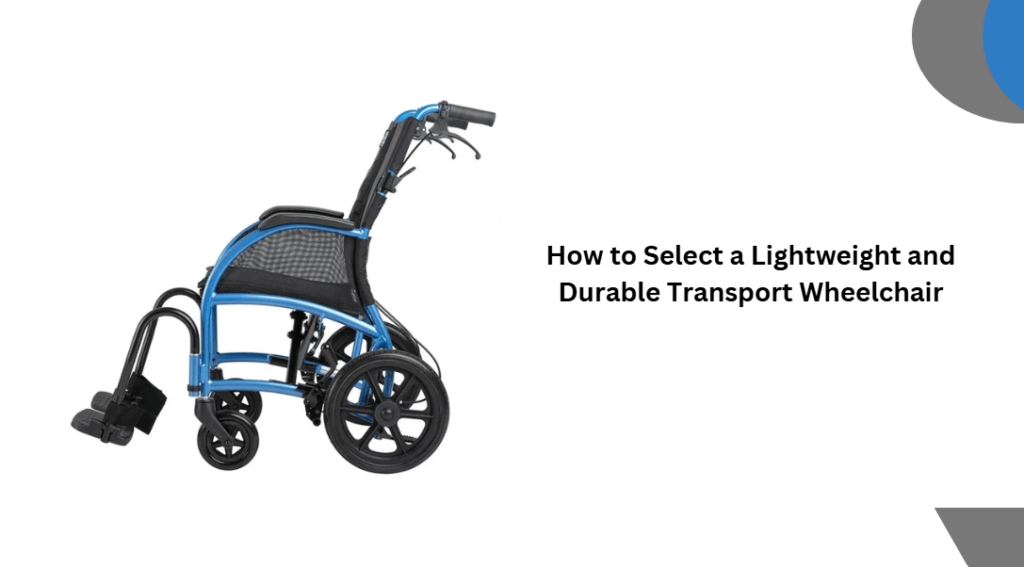
Transport Wheelchair
A transport wheelchair is an essential mobility aid designed to help individuals with limited mobility move easily with the assistance of a caregiver. Unlike self-propelled wheelchairs, transport wheelchairs are lightweight, compact, and easy to maneuver. Choosing the best transport wheelchair involves considering various factors, including durability, comfort, and ease of use. This guide will walk you through the key features to look for when selecting a reliable and lightweight transport wheelchair.
1. Weight and Portability
One of the most important factors when choosing a transport wheelchair is its weight. Since these wheelchairs are designed for caregivers to push, a lightweight frame ensures easy handling. Look for:
- Aluminum or carbon fiber frames for durability without added weight
- Total weight under 20 pounds for effortless lifting and storage
- Foldable design for easy transport in cars or storage at home
A lightweight design makes it easier for caregivers to lift and maneuver the wheelchair in different environments.
2. Frame Durability and Material
Although weight is an essential factor, durability should not be compromised. The best transport wheelchair should have a sturdy frame that withstands daily use. Consider:
- Aluminum frames for a balance of strength and lightness
- Steel frames for extra durability, though slightly heavier
- Reinforced joints and secure locking mechanisms to ensure long-lasting performance
A strong frame ensures the wheelchair can support the user’s weight while remaining easy to push and control.
3. Comfort and Seat Design
Since transport wheelchairs are often used for extended periods, seat comfort is crucial. Look for:
- Padded, breathable seating material to prevent discomfort
- Seat width options (16-22 inches) to accommodate different body types
- Adjustable footrests for better posture support
- Armrests with padding to provide additional comfort
Comfortable seating and ergonomic support help prevent pressure sores and enhance the overall experience for the user.
4. Wheel Size and Maneuverability
The type and size of wheels play a significant role in how well a wheelchair moves. Consider:
- Large rear wheels (8-12 inches) for smoother outdoor use
- Locking rear brakes for added security
- Swivel front wheels for easy turning and navigation
- Solid, puncture-proof tires for durability on different surfaces
A well-designed transport wheelchair should provide a smooth and stable ride, whether indoors or outdoors.
5. Safety Features
Safety should always be a priority when selecting a best transport wheelchair. Essential safety features include:
- Locking hand brakes for caregivers to control movement on slopes
- Seat belts to keep the user securely in place
- Anti-tip bars to prevent accidents
- Reflectors or visibility enhancements for nighttime use
These features ensure a secure and worry-free experience for both the user and caregiver.
6. Storage and Folding Mechanism
A good transport wheelchair should be easy to store and carry. Look for:
- One-touch folding mechanism for quick storage
- Compact design that fits in car trunks
- Removable footrests and fold-down backrest for space efficiency
A foldable wheelchair is ideal for travel and ensures hassle-free storage when not in use.
7. Weight Capacity
Always check the wheelchair’s weight capacity to ensure it supports the user’s needs. Most best transport wheelchair models can accommodate:
- 250-300 lbs for standard models
- 350 lbs or more for heavy-duty options
Selecting the correct weight capacity ensures safety, stability, and longevity of the wheelchair.
8. Additional Features and Customization
Some transport wheelchair models offer extra features for added convenience, including:
- Cup holders and storage pouches for personal items
- Tilt and recline functions for enhanced comfort
- USB charging ports for electronic devices
- Height-adjustable handles for caregiver comfort
These features improve the overall experience and usability of the wheelchair.
9. Comparing Transport vs. Electric Wheelchairs
If the user requires more independence, an electric wheelchair may be a better option. Key differences include:
- Transport wheelchairs require a caregiver for pushing
- Electric wheelchairs offer self-propulsion with a motor
- Transport wheelchairs are lighter and easier to store
- Electric wheelchairs provide more autonomy for users
If the user has strength limitations but prefers self-mobility, an electric wheelchair could be an alternative to consider.
10. Price and Warranty
Finally, ensure that the wheelchair fits your budget while offering good value. Consider:
- Mid-range models ($200-$500) for quality and durability
- High-end models ($600+) for advanced features
- A 1-3 year warranty for peace of mind
- Reliable customer support for maintenance and repairs
A good warranty ensures long-term reliability and cost savings on repairs.
Conclusion
Selecting the best transport wheelchair involves balancing weight, durability, comfort, safety, and budget. A lightweight yet sturdy frame, comfortable seating, reliable safety features, and ease of transport make a wheelchair user-friendly for both caregivers and users. If independence is a concern, exploring an electric wheelchair might be a good alternative.
By considering these key factors, you can confidently choose a transport wheelchair that enhances mobility and improves daily life.




More Stories
Key Considerations for Clinical Trial Packaging and Labeling
8 Reasons Why Moving Into A Care Home Can Be A Positive Thing
What To Expect From A Nursing Care Home